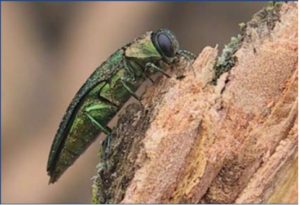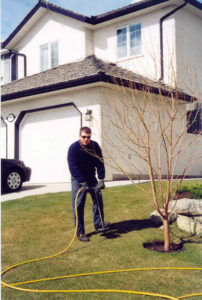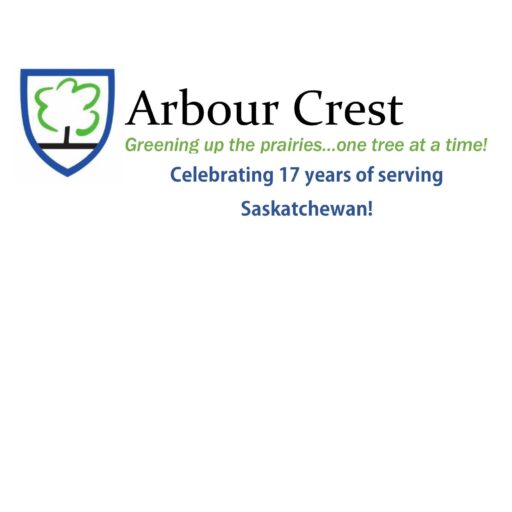Integrated Pest Management Plan for Emerald Ash Borer (Agrilus planipennis)
Introduction

Adult EAB
Emerald Ash Borer (EAB) is an invasive insect originating from Asia and is reported to have arrived in Winnipeg 2017. Since its first discovery, it has spread. North America has an estimated 8.7 Billion Ash and EAB is coming to Saskatoon, it’s just a matter of time. To date there has been no confirmation of EAB in Saskatchewan however, we are equipped and prepared for the issue with years of experience in EAB control.
Life cycle and Important Development

“D-holes”
Adults emerging in May to June will feed on foliage creating C-shaped cuts in leaflets. After feeding, they will mate and lay eggs individually in bark crevices. These eggs are then hatching and tunneling into the vascular tissue (sapwood and phloem) creating feeding galleries and feed until the autumn. Pupation occurs in the spring and are followed by the new adult generation to repeat the cycle. 1 Generation per year.
Damage and Treatment Thresholds

“S-shaped galleries”
The damage to the leaves is negligible compared to the damage by the larval stages in the wood tissue. S-shaped galleries as seen to the left will be hidden under dead bark tissue and will likely go unnoticed until branch dieback is noticed and inspected by a qualified professional. Root dieback in response to crown dieback is not to be underestimated and should be managed as well.
D-Shaped holes, dehydrated patches of bark will be valuable signs to look for along with secluded branch dieback and of course the pest itself. Not to be confused with Cottony Ash Psyllid (https://arbourcrest.com/cottony-ash-psyllid/ ) damage which only affects Black and Manchurian Ash.
Treatment
An integrated pest management plan is the only way to effectively control this invasive insect. It IS possible. Treating your tree will only be a part of the battle. Inoculating against the insect (annually in some cases), planning safety mitigation pruning for branch dieback and managing its health, form and integrity will all be vital to a proper management program. This in addition to a community effort both in municipally and residential settings helps to suppress populations area by area and protect areas not yet affected. Gaining control of this insect will require a treatment or series of treatments. Ask a certified arborist which ones you require based on a site inspection and quote.
Step 1: Treatment type

Systemic Injection
Injection- Systemic insecticide injected into the base of the tree. Over the following 72 hours of treatment insecticide is translocated to the leaves where adults can ingest leaf and insecticide while larva are feeding on inoculated wood tissue.
Dosage rates change depending on whether tree is infected or being protected from infection.
Step 2: Maintaining health

Deep-root fertilizer
Watering- Very important to promoting tree health, the dehydration that occurs in wood tissue is monumental and causes a significant decline in addition to larval feeding galleries. Watering your trees regularly will also aid in the development of new roots.
Spring fertilizer- This will help promote new growth and increase available resources for tree vigor while reducing stresses and helping maintain a healthy tree.
Other pests- Controlling other pests that interfere with tree health is important. With other pests compounding stresses the tree may succumb to these stresses before control is achieved. Example: Forest Tent Caterpillar, Aphids, scale.
Pruning- Whether for safety or for health, pruning will be an important part of your treatment as it will aid in removing dangerous material and infected wood from your tree in a controlled environment.
Step 3: Reinfection control
You and your neighbors- The adult EAB can fly and is capable from moving from one tree to another. If your neighbors have ash trees please have them informed of this issue as their tree can be problematic for you. This also applies to your property if you have trees that are untreated or not quarantined.
Planting- Do not plant Ash as a replacement. No real Ash specie is safe from EAB.
Step 4: Monitoring
Self monitored- Monitoring to establish effectiveness of treatments is important and requires some form of trap. Suggested is a yellow sticky card you can get from your local garden store or nursery as well as traps specifically designed for EAB collection available from Arbour Crest. Noting how many adults are on this card at the end of each adult cycle will help your arborist assess effectiveness of treatments and future requirements. This can be done professionally for you.
Step 5: Adjusting treatments as required
Please keep in contact with your plant healthcare provider as they will adjust treatments and longevity of treatments as required. Depending on the populations in your area, treatment length can change. Treatment until surrounding trees are either treated and clear of psyllid, or until tree is removed is a must. However, treatment types may change depending on severity and location. Set up a consultation with us today to learn more!

